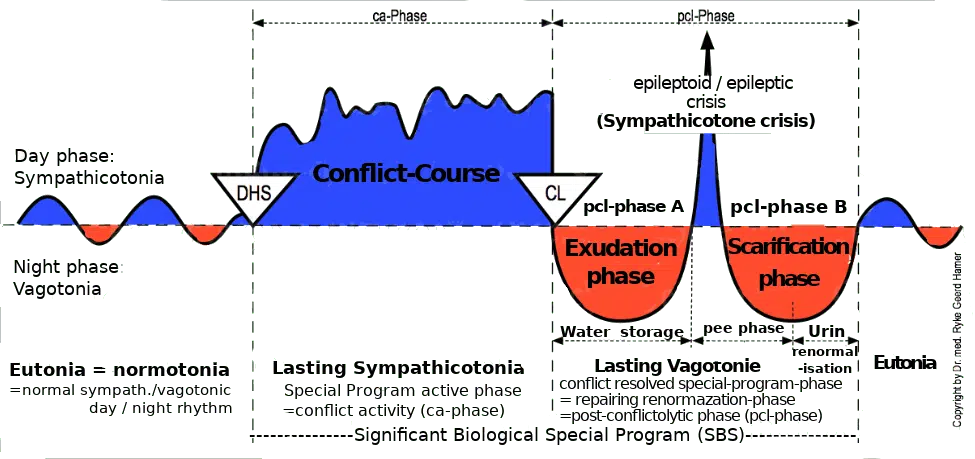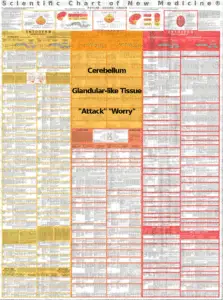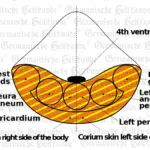Cerebellum = Old Brain = Middle Germ Layer = Mesoderm

Peritoneal Carcinoma right – Diagnostic Chart
Attack against the abdomen.
Example: “You have a liver tumor!” or: “… an intestinal tumor! We have to operate on that (cut open the abdomen)!” For the integrity of the abdominal cavity. It can also be perceived in a figurative sense, for example, a bad word or an insult as a blow or stab in the abdomen, as an injury.
We distinguish the parietal peritoneum (lining the body cavity) and the visceral peritoneum (enveloping the individual organs). Also, there are the retroperitoneal organs, e.g., the kidneys and the pancreas.
–
HH in the middle, lateral cerebellum on the left.
Pleura and peritoneum are located in the same place in the cerebellum and used to be one organ before the diaphragm was retracted as an “intermediate cover.”
Following the DHS, growth of small- or large-nodular compact so-called mesotheliomas, depending on whether the patient feels attacked “as a whole” or at a specific site. The laterality of the mesothelioma has nothing to do with an existing tumor, but only with where the patient felt the attack.
Ascites. The mesotheliomas are cauterized tuberculously (biolog. healing), encapsulated (non-biolog. healing), or both. The purpose of ascites is that the intestines do not fuse in this process, and obstruction is avoided. The intestines “float” in ascites.
Centralization
Active phase
Thickening of the peritoneum to prevent an expected sting or blow; also mental: “You have cancer, we have to operate immediately!”
ATTENTION: Do not puncture ascites if possible. The ascites (peritoneal effusion) are noticed all the more dramatically if an active refugee conflict exists simultaneously (syndrome). After expired TBC, we often find the usual calcification.
Therefore, therapeutic, it is recommended to solve the refugee conflict, existential conflict, being left alone conflict because this will reduce the ascites by half or even more. Regarding transudative ascites, see Healing bone osteolysis = leukemia, in this case, with active refugee conflict = gout. The retroperitoneum (i.e., the “backward-facing” part of the peritoneum) can make so-called renal ascites. The kidney then “floats” in the ascites or is embedded in a very fluid-containing peritoneal tissue, which may also consist of ascitic fluid (see also calcification after expired peritoneal TB in the renal bed.


TODAY: 0
LAST 30 DAYS: 3.905
THIS YEAR: 32.204
TOTAL: 151.319
| Cookie | Duration | Description |
|---|---|---|
| cookielawinfo-checkbox-analytics | 11 months | This cookie is set by GDPR Cookie Consent plugin. The cookie is used to store the user consent for the cookies in the category "Analytics". |
| cookielawinfo-checkbox-functional | 11 months | The cookie is set by GDPR cookie consent to record the user consent for the cookies in the category "Functional". |
| cookielawinfo-checkbox-necessary | 11 months | This cookie is set by GDPR Cookie Consent plugin. The cookies is used to store the user consent for the cookies in the category "Necessary". |
| cookielawinfo-checkbox-others | 11 months | This cookie is set by GDPR Cookie Consent plugin. The cookie is used to store the user consent for the cookies in the category "Other. |
| cookielawinfo-checkbox-performance | 11 months | This cookie is set by GDPR Cookie Consent plugin. The cookie is used to store the user consent for the cookies in the category "Performance". |
| viewed_cookie_policy | 11 months | The cookie is set by the GDPR Cookie Consent plugin and is used to store whether or not user has consented to the use of cookies. It does not store any personal data. |
You’ll be informed by email when we post new articles and novelties. In every email there is a link to modify or cancel your subscription.